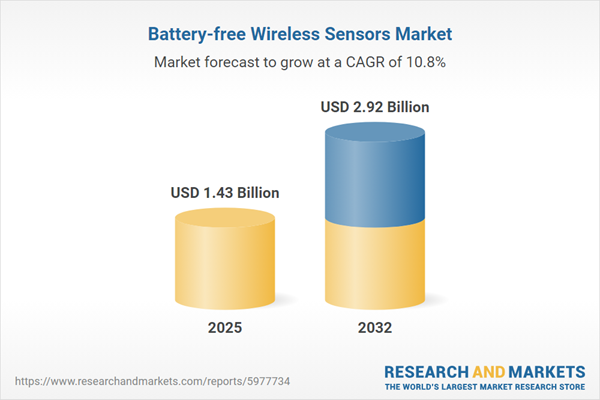Speak directly to the analyst to clarify any post sales queries you may have.
Battery-free wireless sensors are emerging as a foundational element in modern enterprise digital infrastructure, enabling streamlined workflows, enhanced sustainability practices, and reliable technology lifecycles. For senior decision-makers, these sensors represent an opportunity to synchronize digital initiatives with strategic goals while supporting evolving market demands.
Market Snapshot: Battery-Free Wireless Sensors
The battery-free wireless sensors market is advancing at a steady pace, shaped by ongoing energy harvesting innovations and new developments in semiconductor design. In 2024, the sector stands at USD 1.29 billion, with projected growth to USD 1.43 billion in 2025 and USD 2.92 billion by 2032, yielding a compound annual growth rate (CAGR) of 10.77%. Uptake is most prevalent in manufacturing, agriculture, automotive, and healthcare, where organizations prioritize compliance with regulatory standards and pursue sustainability strategies. Demand is further sustained by a preference for interoperable IoT infrastructures, which enable organizations in diverse regions to implement future-ready, scalable sensor solutions that adapt to changing requirements.
Scope & Segmentation of Battery-Free Wireless Sensors
This report delivers in-depth segmentation and actionable insights to empower senior executives in strategic planning and risk mitigation. Each segment details specific value opportunities driven by current market and technology trends:
- Sensor Types: NFC-enabled units for secure access control; photovoltaic sensors utilizing ambient light; piezoelectric devices converting movement into energy; RFID-enabled models supporting asset tracking; thermoelectric sensors for adverse environments; vibration-based options for industrial automation.
- Applications: Solutions deployed for asset tracking in distributed supply chains, automotive process automation, remote monitoring of environmental conditions, medical wearables facilitating continuous oversight, process enhancement in industry, inventory management in retail, and agricultural monitoring for both crops and livestock.
- End Users: Widespread adoption spans agriculture, automotive, manufacturing, energy, government, healthcare, retail, and electronics, reflecting a broad need for digital transformation support.
- Communication Protocols: Technologies in use include Bluetooth backscatter for energy efficiency, LoRa for wide-area communication, NFC and RFID for proximity tasks, as well as Wi-Fi backscatter and Zigbee for device-rich environments.
- Installation Types: Offerings include embedded OEM integration, retrofitting for legacy infrastructure, distributed standalone monitoring, and wearables tailored to personnel or healthcare requirements.
- Ranges: Sensors are designed for long-range deployment across industrial sites, medium-range coverage in commercial spaces, and short-range collection suited to localized analytics.
- Energy Harvesting Mechanisms: Deployment options harness photovoltaic, piezoelectric, thermoelectric, passive RFID, and vibration-based harvesting methods to maximize operational longevity while minimizing maintenance.
- Sales Channels: Products are accessible through direct system integrators, specialized distributors, embedded OEM agreements, and digital procurement.
- Regions: Analysis covers adoption across the Americas, Europe, Middle East & Africa, and Asia-Pacific, with detailed focus on regions such as the US, Canada, Brazil, UK, Germany, France, UAE, China, India, and Japan.
- Companies Profiled: The report features EnOcean GmbH, Avery Dennison Corporation, Impinj Inc., NXP Semiconductors N.V., Texas Instruments Incorporated, STMicroelectronics International N.V., Alien Technology Corporation, Wiliot Ltd., TE Connectivity Ltd., and EM Microelectronic-Marin SA.
Key Takeaways: Strategic Benefits of Battery-Free Wireless Sensors
- Deployments at remote or difficult-to-service sites lower maintenance frequency and simplify operational processes.
- Modular system architectures allow seamless upgrades or retrofits, protecting investments in existing equipment while facilitating smooth transitions to newer technologies.
- Low-power integrated processing capabilities drive efficiency improvements and support sustainability by aiding cost-reduction and energy management programs.
- Interoperability with established connectivity standards enables easier integration with current systems and supports ongoing regulatory compliance.
- Enhanced monitoring and data collection support predictive analytics capabilities, improving risk management and asset visibility across the organization.
- Scalable solutions offer quick access to actionable insights, equipping leaders with timely intelligence to inform strategy and operations.
Tariff Impact and Supply Chain Strategies
Recent shifts in U.S. tariff policies have encouraged organizations to diversify their supplier networks and investigate alternative manufacturing geographies. This strategic adaptation enhances overall supply chain resilience by mitigating risks related to global trade fluctuations.
Methodology & Data Sources
The research approach comprises multi-phase analysis, merging review of intellectual property portfolios, regulatory assessments, and interviews with technology and manufacturing partners. All data is validated using third-party sources to ensure accuracy and reliability in executive decision-making.
Why This Report Matters
- Granular segmentation combined with sector-specific analysis equips senior leadership with the right intelligence to plan technology rollouts that address unique operational realities.
- Detailed insights into regulations and supply chain trends enable proactive compliance and resilience planning, mitigating business continuity risks.
- Actionable, independently validated intelligence empowers confident, timely choices on wireless sensor investments for enhanced cross-functional performance.
Conclusion
Battery-free wireless sensors are crucial for launching secure and efficient IoT strategies. This report delivers leadership with clear, reliable guidance to drive technology modernization in an evolving global environment.
Additional Product Information:
- Purchase of this report includes 1 year online access with quarterly updates.
- This report can be updated on request. Please contact our Customer Experience team using the Ask a Question widget on our website.
Table of Contents
3. Executive Summary
4. Market Overview
7. Cumulative Impact of Artificial Intelligence 2025
Companies Mentioned
The companies profiled in this Battery-free Wireless Sensors market report include:- EnOcean GmbH
- Avery Dennison Corporation
- Impinj, Inc.
- NXP Semiconductors N.V.
- Texas Instruments Incorporated
- STMicroelectronics International N.V.
- Alien Technology Corporation
- Wiliot Ltd.
- TE Connectivity Ltd.
- EM Microelectronic-Marin SA
Table Information
| Report Attribute | Details |
|---|---|
| No. of Pages | 186 |
| Published | November 2025 |
| Forecast Period | 2025 - 2032 |
| Estimated Market Value ( USD | $ 1.43 Billion |
| Forecasted Market Value ( USD | $ 2.92 Billion |
| Compound Annual Growth Rate | 10.7% |
| Regions Covered | Global |
| No. of Companies Mentioned | 11 |









